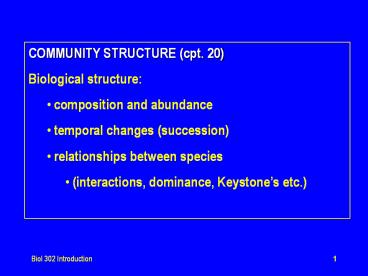COMMUNITY STRUCTURE (cpt. 20) - PowerPoint PPT Presentation
Title:
COMMUNITY STRUCTURE (cpt. 20)
Description:
This can be used to characterize a community because ... Warblers in a coniferous forest. Aquatic systems. Soil layers. Root systems. Biol 302 Introduction ... – PowerPoint PPT presentation
Number of Views:71
Avg rating:3.0/5.0
Title: COMMUNITY STRUCTURE (cpt. 20)
1
- COMMUNITY STRUCTURE (cpt. 20)
- Biological structure
- composition and abundance
- temporal changes (succession)
- relationships between species
- (interactions, dominance, Keystones etc.)
2
- COMMUNITY STRUCTURE (cpt. 20)
- Biological structure determines how
- the community functions
- Productivity
- Trophic levels
- Nutrient cycling etc.
3
- VARIOUS WAYS TO DESCRIBE COMMUNITY STRUCTURE
- LIFE FORMS
- HORIZONTAL STRUCTURE
- VERTICAL STRUCTURE
4
- VARIOUS WAYS TO DESCRIBE COMMUNITY STRUCTURE
- LIFE FORMS
- HORIZONTAL STRUCTURE
- VERTICAL STRUCTURE
5
LIFE FORMS In the 1920s, a Danish botanist,
Raunkiaer, provided a classification (1934) based
on the position of the perennating tissue (buds,
bulbs, seeds etc.). This can be used to
characterize a community because certain life
forms are dominant in certain environments.
6
Christen C. Raunkiaer 1860-1938
7
RAUNKIAERS LIFE FORMS
Phanerophytes (trees)
Hemicryptophytes (perennial herbs)
Therophytes (annuals)
Cryptophytes (bulbs etc.)
Chamaephytes (shrubs)
8
- The great biomes of the world show a remarkable
degree of convergence in their physical
appearance, despite wide variation in the
species involved. - It is difficult to distinguish between
- chaparral of California and Chile
- nutrient-poor heaths of S. Africa and Australia
- Arctic and Antarctic fell fields
- rain forest in Brazil and SE Asia
- These divergences are vivid testimony of the
importance of climatic factors as agents of
natural selection.
9
LIFE FORMS IN DIFFERENT BIOMES
10
Phanerophytes (trees) Chamaephytes (shrubs) Hemicryptophytes (perennial herbs) Cryptophytes (bulbs etc.) Thero phytes (annuals)
World or Normal 46 9 26 6 13
LATITUDE
Tropical rain forest 96 2 2
Sub tropical forest 65 17 2 5 10
Warm temperate forest 54 9 24 9 4
Cold temperature forest 10 17 54 12 7
Tundra 1 22 60 15 2
11
Phanerophytes (trees) Chamaephytes (shrubs) Hemicryptophytes (perennial herbs) Cryptophytes (bulbs etc.) Thero phytes (annuals)
World or Normal 46 9 26 6 13
MOISTURE
Mesophytic forest 34 8 33 23 2
Oak woodland 30 23 36 5 6
Dry grassland 1 12 63 10 14
Semi-desert 59 14 27
Desert 4 17 6 73
12
- SEVERAL POINTS EMERGE FROM THESE COMPARISONS
- Where there is no unfavorable season, or the less
favorable is not too severe, then tree-like
plants (phanerophytes) predominate in the flora
as a whole. - Under ideal growth conditions (constant warmth
and moisture) trees are dominant, simply because
the competitive spoils go to the tallest
individuals. - In less equable climates, trees may still be the
dominant plants in most communities, but the
flora as a whole is made up predominantly of
other life forms (hemicryptophytes in northern
temperate latitudes)
13
Where the summer is arid (as in deserts and
Mediterranean climates), there is a preponderance
of annual plants (which avoid drought by passing
the dry period as dormant seeds) and geophytes
(which avoid drought by die-back of their
above-ground parts and survive by means of
underground storage organs). Other desert plants
that tolerate drought may appear to be dominant
if the vegetation is surveyed during the dry
season (xerophytic shrubs and stem succulents)
- Where the summer is arid (as in deserts and
Mediterranean climates), there is a preponderance
of annual plants (which avoid drought by passing
the dry period as dormant seeds) and geophytes
(which avoid drought by die-back of their
above-ground parts and survive by means of
underground storage organs). Other desert plants
that tolerate drought may appear to be dominant
if the vegetation is surveyed during the dry
season (xerophytic shrubs and stem succulents)
14
5. Where extreme cold and exposure characterize
the unfavorable season, there is a shift towards
cushion-forming plants and other species whose
buds are held close to the ground surface
(chamaephytes). Many Arctic plants have their
perennating buds protected by the dead leaf-bases
of last year's shoots, because both the exposed
aerial environment and the frozen soil are
extremely inhospitable conditions for bud
survival.
15
- VARIOUS WAYS TO DESCRIBE COMMUNITY STRUCTURE
- LIFE FORMS
- HORIZONTAL STRUCTURE
- VERTICAL STRUCTURE
16
- HORIZONTAL STRUCTURE
- Random
- Probably never occurs
- Regular or Systematic
- Plantations of crops
- Behavioural interactions
- Aggregated or Clumped
17
- HORIZONTAL STRUCTURE
- Random
- Probably never occurs
- Regular or Systematic
- Plantations of crops
- Behavioural interactions
- Aggregated or Clumped
18
RANDOM ARRANGEMENT
19
- HORIZONTAL STRUCTURE
- Random
- Probably never occurs
- Regular or Systematic
- Plantations of crops
- Behavioural interactions
- Aggregated or Clumped
20
REGULAR OR SYSTEMATIC ARRANGEMENT
21
REGULAR, OR SYSTEMATIC, ARRANGEMENT
22
- HORIZONTAL STRUCTURE
- Random
- Probably never occurs
- Regular or Systematic
- Plantations of crops
- Behavioural interactions
- Aggregated or Clumped
23
- AGGREGATED
- ants and termites
- fish and phytoplankton
- plants
- distribution from parent
- environmental heterogeneity
- species interactions
24
- AGGREGATED
- ants and termites
- fish and phytoplankton
- plants
- distribution from parent
- environmental heterogeneity
- species interactions
25
- AGGREGATED
- ants and termites
- fish and phytoplankton
- plants
- distribution from parent
- environmental heterogeneity
- species interactions
26
Solidago canadensis
Solidago nemoralis
27
Buttercup (Ranunculus sp.)
28
BullrushCattail
29
Krebs Fig. 7.9 p94,95,137
Chthamalus
Balanus
30
- VARIOUS WAYS TO DESCRIBE COMMUNITY STRUCTURE
- LIFE FORMS
- HORIZONTAL STRUCTURE
- VERTICAL STRUCTURE
31
- VERTICAL STRUCTURE
- Forest (usually associated with light
diminution) - Warblers in a coniferous forest
- Aquatic systems
- Soil layers
- Root systems
32
(No Transcript)
33
WARBLERS
(Krebs Fig. 12.15 p193)
34
(Krebs Fig. 12.15 p193)
35
(No Transcript)
36
(No Transcript)































